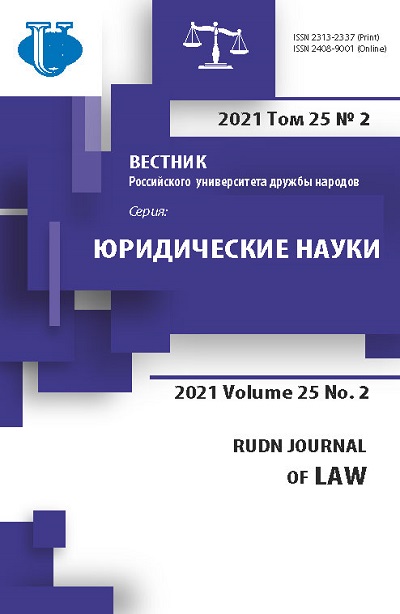International legal, technical and financial challenges for implementing the concept of space traffic management
- Authors: Abashidze A.K.1, Solntsev A.M.1, Mirzaee S.2, Davarzani M.3
-
Affiliations:
- Peoples’ Friendship University of Russia (RUDN University)
- Islamic Azad University (IAUEC)
- Shahid Beheshti University
- Issue: Vol 25, No 2 (2021)
- Pages: 700-713
- Section: INTERNATIONAL LAW. FOREIGN LAW
- URL: https://journals.rudn.ru/law/article/view/26721
- DOI: https://doi.org/10.22363/2313-2337-2021-25-2-700-713
- ID: 26721
Cite item
Full Text
Abstract
Focuses on the concept of Space Traffic Management (STM), the matter which has been of high interest for many space actors in the last three decades. With the emergence of the NewSpace era, and flourishment of commercial and economic incentives for space activities, this topic has gained the attention of many space actors in the preceding decades, thus turning into a separate agenda item in the Legal Subcommittee of the United Nations Committee on the Peaceful Uses of Outer Space. However, establishing and implementing such regulations is a challenging task, especially for new space actors. This article aims to assess the existing challenges of STM and provide solutions to overcome them. Firstly, this article provides the necessity of establishing such a regulation: it is evaluated and discussed while describing the requirements for achieving this goal. Secondly, the paper studies definitions provided by governmental and non-governmental entities regarding this concept and the measures taken towards its realising. Finally, the research discusses the challenges that space actors face regarding implementing this concept, both legal and practical. In conclusion, the authors highlight the importance of promoting endeavours and coordination among all current and potential space actors with due considerations for their relevancy.
About the authors
Aslan Kh. Abashidze
Peoples’ Friendship University of Russia (RUDN University)
Author for correspondence.
Email: abashidze-akh@rudn.ru
ORCID iD: 0000-0003-0012-8795
Doctor of Legal Sciences, Profession of the the department of International Law, Law Institute
6 Miklukho-Maklaya str., Moscow, 117198, Russian FederationAlexander M. Solntsev
Peoples’ Friendship University of Russia (RUDN University)
Email: solntsev-am@rudn.ru
ORCID iD: 0000-0002-9804-8912
Candidate of Legal Science, Associate Professor, Profession of the the department of International Law, Law Institute
6 Miklukho-Maklaya str., Moscow, 117198, Russian FederationSiavash Mirzaee
Islamic Azad University (IAUEC)
Email: siavash.mirzaei1988@gmail.com
ORCID iD: 0000-0001-5086-7778
Candidate of Legal Science, University Lecturer
8th Neyestan, Teheran, Islamic Republic of IranMahdi Davarzani
Shahid Beheshti University
Email: mahyardavarzani@gmail.com
M.A. in International Law
Daneshjou Blvd., Teheran, Islamic Republic of Iran, 19839 69411References
- Ailor, W. (2015) Space Traffic Management. In: Schrogl KU., Hays P., Robinson J., Moura D., Giannopapa C. (eds.) Handbook of Space Security. Springer, New York, NY. DOI: https://doi.org/10.1007/978-1-4614-2029-3_58
- Aliberti, M., Sarret, M., Hrozensky, T., Perrichon, L. & Rowley, J. (2018) Security in Outer Space: Perspectives on Transatlantic Relations. Vienna: European Space Policy Institute (ESPI). Report number: 66. Available at: https://espi.or.at/publications/espi-public-reports/send/ 2-public-espi-reports/394-security-in-outer-space-transatlantic-relations [Accessed 14th October 2020]
- Benkö, M., Schrogl, K.U., Digrell, D., & Jolley, E. (eds.) (2005) Space law: Current problems and perspectives for future regulation. Utrecht, The Netherlands: Eleven International Pub.
- Blount, P.J. (2019). Space Traffic Management: Standardizing On-Orbit Behavior. AJIL Unbound. (113), 120-124.
- Cheng, B. (1983) The Legal Status of Outer Space and Relevant Issues: Delimitation of Outer Space and Definition of Peaceful Use. Journal of Space law. (11), 89-105.
- Contant-Jorgenson, C., Lála, P., & Schrogl, K. (2006) Space Traffic Management. International Academy of Astronautics (IAA). Available at: https://black-holes.eu/resources/ IAA_spacetrafficmanagement.pdf [Accessed 8th October 2020]
- Davarzani, M. (2018) Legal Analysis of Theories Regarding Air and Space Boundary. Diss… Shahid Beheshti University.
- Henri, Y. (2015) Frequency Management and Space Traffic Management. Technical. [Presentation] International Telecommunication Union.
- Hobe, S. (ed.) (2013) Cologne Commentary on Space Law. T. 2. Rescue Agreement, Liability Convention, Registration Convention, Moon Agreement. Köln: Heymann.
- Jakhu, R.S., Sgobba, T., & Dempsey, P.S. (eds.). (2011) Background. In: Jakhu R.S., Sgobba T., Dempsey P.S. (eds) The Need for an Integrated Regulatory Regime for Aviation and Space: ICAO for Space. Studies in Space Policy, Vol 7. Springer, Vienna. pp. 1-17. DOI: https://doi.org/10.1007/978-3-7091-0718-8_1
- Lal, B., & Nightingale, E. (2014) Where is Space? And Why Does That Matter? Space Traffic Management Conference. (16), 1-17
- Mirzaee, S. (2017) Outer Space and Common Heritage of Mankind: Challenges and Solutions. RUDN Journal of Law. 21(1), 102-114
- Moranta, S., Hrozensky, T., & Dvoracek, M. (2020) Towards a European Approach to Space Traffic Management. Vienna: European Space Policy Institute (ESPI). Report number: 71. Available at: https://espi.or.at/publications/espi-public-reports/send/2-public-espi-reports/ 494-espi-report-71-stm [Accessed 8th October 2020]
- Peterson, G.E., Sorge, M.E., McVey, J.P., Gegenheimer, S. & Henning, G.A. (2018) Tracking Requirements in Leo For Space Traffic Management in The Presence of Proposed Small Satellite Constellations. IAF. IAC-18, A6. 7.6, x43991, 1-5
- Stillwell, R. (2019) Decentralized Space Traffic Management. Conference. 6. Available at: https://commons.erau.edu/cgi/viewcontent.cgi?article=1235&context=stm [Accessed 23rd October 2020].
- Syed Tamjeed. A. (2020) Wanted: A Robust Legal Regime for Regulating Space Traffic. Available at: http://www.theleaflet.in/21529-2 [Accessed 23rd October 2020].
- Takeuchi, Yu. (2014) Legal Aspects of International Regime for Space Traffic Management. Diss… McGill University.
- Wheeler, Joanne (2014) Space Debris: The Legal Issues. Available at: https://www.aerosociety. com/news/space-debris-the-legal-issues/ [Accessed 26th October 2020]
- Wicker, R. (2020) Wicker Introduces Bill to Codify Commerce’s Role in Space Situational Awareness. Available at: https://spacepolicyonline.com/news/wicker-introduces-bill-to-codify-commerces-role-in-space-situationa [Accessed 26th October 2020]
Supplementary files















